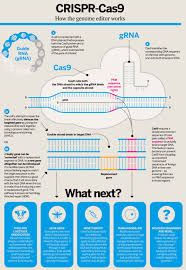ALS, amyotrophic lateral sclerosis, is a nervous system disease that weakens muscles and impacts physical functions. ALS is diagnosed in less than 20,000 people a year but there is currently no cure. Amyotrophic lateral sclerosis is caused by protein clumps in the brain which make voluntary movements progressively harder. The protein clumps destroy neurons in the brain through toxins. Scientist are yet to figure out how the toxins do this. A group of researches then decided to use CRISPR-Cas9 to get a better understanding of what is actually happening. During their research they realized that when a gene was affected it protected the neurons. It was already known that a gene called C9orf72 caused for unnatural repeating in certain parts of DNA and is the cause for the build up of proteins in ALS. The research group isolated certain genes by knocking out others. During this process they realized that when the gene Tmx2 is inactive it hindered cell deaths in mouse neurons. “If you have a small molecule that could somehow impede the function of Tmx2, there might be a therapeutic window there” said co-author Micheal Haney. Michael Bassik, Ph.D., assistant professor of genetics at Stanford and other reaserchers plan to do more studies on Tmx2 to get more detailed and accurate information. They also plan on doing CRISPR screens to find other possible causes for ALS and work on cures for other neurodegenerative disorders.
Other researchers are trying to use CRISPR-Cas9 to find a cure to ALS. Researchers are beginning to focus on editing RNA in hopes to cure a form ALS and other neurodegenerative diseases.This technique has produced mixed results. Research at the University of California, Riverside, has made progress in developing a molecule which can target EphA, this is a “gene that’s known to govern the onset and progression of neurodegenerative diseases”.
You can read more here.



Leave a Reply